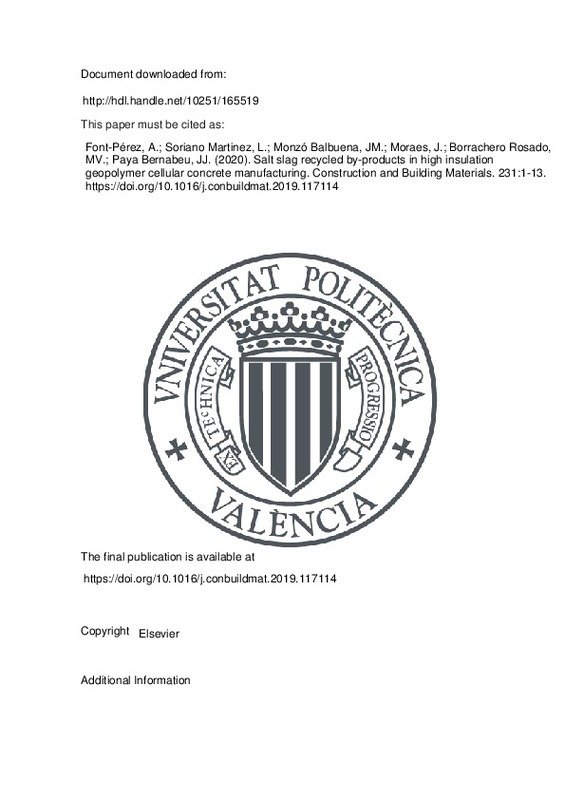Meyer, C. (2009). The greening of the concrete industry. Cement and Concrete Composites, 31(8), 601-605. doi:10.1016/j.cemconcomp.2008.12.010
Petek Gursel, A., Masanet, E., Horvath, A., & Stadel, A. (2014). Life-cycle inventory analysis of concrete production: A critical review. Cement and Concrete Composites, 51, 38-48. doi:10.1016/j.cemconcomp.2014.03.005
Panesar, D. K. (2013). Cellular concrete properties and the effect of synthetic and protein foaming agents. Construction and Building Materials, 44, 575-584. doi:10.1016/j.conbuildmat.2013.03.024
[+]
Meyer, C. (2009). The greening of the concrete industry. Cement and Concrete Composites, 31(8), 601-605. doi:10.1016/j.cemconcomp.2008.12.010
Petek Gursel, A., Masanet, E., Horvath, A., & Stadel, A. (2014). Life-cycle inventory analysis of concrete production: A critical review. Cement and Concrete Composites, 51, 38-48. doi:10.1016/j.cemconcomp.2014.03.005
Panesar, D. K. (2013). Cellular concrete properties and the effect of synthetic and protein foaming agents. Construction and Building Materials, 44, 575-584. doi:10.1016/j.conbuildmat.2013.03.024
B. Dolton, C. Hannah, Cellular Concrete : Engineering and Technological Advancement for Construction in Cold Climates, (2006) 1–11.
Narayanan, N., & Ramamurthy, K. (2000). Structure and properties of aerated concrete: a review. Cement and Concrete Composites, 22(5), 321-329. doi:10.1016/s0958-9465(00)00016-0
Holt, E., & Raivio, P. (2005). Use of gasification residues in aerated autoclaved concrete. Cement and Concrete Research, 35(4), 796-802. doi:10.1016/j.cemconres.2004.05.005
Mo, K. H., Alengaram, U. J., Jumaat, M. Z., Yap, S. P., & Lee, S. C. (2016). Green concrete partially comprised of farming waste residues: a review. Journal of Cleaner Production, 117, 122-138. doi:10.1016/j.jclepro.2016.01.022
Luukkonen, T., Abdollahnejad, Z., Yliniemi, J., Kinnunen, P., & Illikainen, M. (2018). One-part alkali-activated materials: A review. Cement and Concrete Research, 103, 21-34. doi:10.1016/j.cemconres.2017.10.001
Duxson, P., Provis, J. L., Lukey, G. C., & van Deventer, J. S. J. (2007). The role of inorganic polymer technology in the development of ‘green concrete’. Cement and Concrete Research, 37(12), 1590-1597. doi:10.1016/j.cemconres.2007.08.018
Ducman, V., & Korat, L. (2016). Characterization of geopolymer fly-ash based foams obtained with the addition of Al powder or H2O2 as foaming agents. Materials Characterization, 113, 207-213. doi:10.1016/j.matchar.2016.01.019
Esmaily, H., & Nuranian, H. (2012). Non-autoclaved high strength cellular concrete from alkali activated slag. Construction and Building Materials, 26(1), 200-206. doi:10.1016/j.conbuildmat.2011.06.010
Font, A., Borrachero, M. V., Soriano, L., Monzó, J., & Payá, J. (2017). Geopolymer eco-cellular concrete (GECC) based on fluid catalytic cracking catalyst residue (FCC) with addition of recycled aluminium foil powder. Journal of Cleaner Production, 168, 1120-1131. doi:10.1016/j.jclepro.2017.09.110
Font, A., Borrachero, M. V., Soriano, L., Monzó, J., Mellado, A., & Payá, J. (2018). New eco-cellular concretes: sustainable and energy-efficient materials. Green Chemistry, 20(20), 4684-4694. doi:10.1039/c8gc02066c
Arellano Aguilar, R., Burciaga Díaz, O., & Escalante García, J. I. (2010). Lightweight concretes of activated metakaolin-fly ash binders, with blast furnace slag aggregates. Construction and Building Materials, 24(7), 1166-1175. doi:10.1016/j.conbuildmat.2009.12.024
RLG International cementreview, (n.d.).
World Aluminium, Environmental Metrics Report Year 2010 Data Final, (2014) 21.
Hong, S.-H., Lee, D.-W., & Kim, B.-K. (2000). Manufacturing of aluminum flake powder from foil scrap by dry ball milling process. Journal of Materials Processing Technology, 100(1-3), 105-109. doi:10.1016/s0924-0136(99)00469-0
A. Al Ashraf, Energy Consumption and the CO2 footprint in aluminium production, (2014).
Befesa :: Press :: News archive :: 2013, (n.d.). http://www.befesa.es/web/en/prensa/historico_de_noticias/2013/bma_20130307.html (accessed April 15, 2018).
Araújo, E. G. de, & Tenório, J. A. S. (2005). Cellular Concrete with Addition of Aluminum Recycled Foil Powders. Materials Science Forum, 498-499, 198-204. doi:10.4028/www.scientific.net/msf.498-499.198
Song, Y., Li, B., Yang, E.-H., Liu, Y., & Ding, T. (2015). Feasibility study on utilization of municipal solid waste incineration bottom ash as aerating agent for the production of autoclaved aerated concrete. Cement and Concrete Composites, 56, 51-58. doi:10.1016/j.cemconcomp.2014.11.006
Moraes, J. C. B., Tashima, M. M., Akasaki, J. L., Melges, J. L. P., Monzó, J., Borrachero, M. V., … Payá, J. (2016). Increasing the sustainability of alkali-activated binders: The use of sugar cane straw ash (SCSA). Construction and Building Materials, 124, 148-154. doi:10.1016/j.conbuildmat.2016.07.090
N.E. En, N. Une-en, española, (2005).
F. Babbitt, R.E. Barnett, M.L. Cornelius, B.T. Dye, D.L. Liotti, S.B. Schmidt, J.E. Tanner, S.C. Valentini, ACI 523.3R-14 Guide for Cellular Concretes above 50 lb/ft3 (800 kg/m3), 2014.
ASTM International, ASTM D5334 – 14 Standard Test Method for Determination of Thermal Conductivity of Soil and Soft Rock by Thermal Needle Probe Procedure, (n.d.).
IEEE 442-1981 – IEEE Guide for Soil Thermal Resistivity Measurements, (n.d.).
D.R. van Boggelen, Safe aluminium dosing in AAC plants, 5th Int. Conf. Autoclaved Aerated Concr. (2011) 45–50.
Porciúncula, C. B., Marcilio, N. R., Tessaro, I. C., & Gerchmann, M. (2012). Production of hydrogen in the reaction between aluminum and water in the presence of NaOH and KOH. Brazilian Journal of Chemical Engineering, 29(2), 337-348. doi:10.1590/s0104-66322012000200014
Aleksandrov, Y. A., Tsyganova, E. I., & Pisarev, A. L. (2003). Russian Journal of General Chemistry, 73(5), 689-694. doi:10.1023/a:1026114331597
Yang, K.-H., Lee, K.-H., Song, J.-K., & Gong, M.-H. (2014). Properties and sustainability of alkali-activated slag foamed concrete. Journal of Cleaner Production, 68, 226-233. doi:10.1016/j.jclepro.2013.12.068
Sanjayan, J. G., Nazari, A., Chen, L., & Nguyen, G. H. (2015). Physical and mechanical properties of lightweight aerated geopolymer. Construction and Building Materials, 79, 236-244. doi:10.1016/j.conbuildmat.2015.01.043
Nambiar, E. K. K., & Ramamurthy, K. (2007). Air‐void characterisation of foam concrete. Cement and Concrete Research, 37(2), 221-230. doi:10.1016/j.cemconres.2006.10.009
Narayanan, N., & Ramamurthy, K. (2000). Microstructural investigations on aerated concrete. Cement and Concrete Research, 30(3), 457-464. doi:10.1016/s0008-8846(00)00199-x
Alexanderson, J. (1979). Relations between structure and mechanical properties of autoclaved aerated concrete. Cement and Concrete Research, 9(4), 507-514. doi:10.1016/0008-8846(79)90049-8
[-]







![[Cerrado]](/themes/UPV/images/candado.png)


